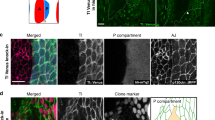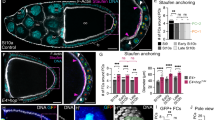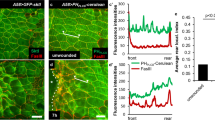Abstract
The Drosophila melanogaster anterior–posterior axis becomes polarized early during oogenesis by the posterior localization of the oocyte within the egg chamber. The invariant position of the oocyte is thought to be driven by an upregulation of the adhesion molecule DE-cadherin in the oocyte and the posterior somatic follicle cells, providing the first in vivo example of cell sorting that is specified by quantitative differences in cell–cell adhesion1,2. However, it has remained unclear how DE-cadherin levels are regulated. Here, we show that talin, known for its role in linking integrins to the actin cytoskeleton, has the unexpected function of specifically inhibiting DE-cadherin transcription. Follicle cells that are mutant for talin show a strikingly high level of DE-cadherin, due to elevated transcription of DE-cadherin. We demonstrate that this deregulation of DE-cadherin is sufficient to attract the oocyte to lateral and anterior positions. Surprisingly, this function of talin is independent of integrins. These results uncover a new role for talin in regulating cadherin-mediated cell adhesion.
This is a preview of subscription content, access via your institution
Access options
Subscribe to this journal
Receive 12 print issues and online access
$209.00 per year
only $17.42 per issue
Buy this article
- Purchase on Springer Link
- Instant access to full article PDF
Prices may be subject to local taxes which are calculated during checkout





Similar content being viewed by others
References
Godt, D. & Tepass, U. Drosophila oocyte localization is mediated by differential cadherin-based adhesion. Nature 395, 387–391 (1998).
Gonzalez-Reyes, A. & St Johnston, D. The Drosophila AP axis is polarised by the cadherin-mediated positioning of the oocyte. Development 125, 3635–3644 (1998).
Wheelock, M. J. & Johnson, K. R. Cadherins as modulators of cellular phenotype. Annu. Rev. Cell Dev. Biol. 19, 207–235 (2003).
Bokel, C. & Brown, N. H. Integrins in development: moving on, responding to, and sticking to the extracellular matrix. Dev. Cell 3, 311–321 (2002).
Hynes, R. O. Integrins: bidirectional, allosteric signaling machines. Cell 110, 673–687 (2002).
Avizienyte, E. et al. Src-induced de-regulation of E-cadherin in colon cancer cells requires integrin signalling. Nature Cell Biol. 4, 632–638 (2002).
Tepass, U., Godt, D. & Winklbauer, R. Cell sorting in animal development: signalling and adhesive mechanisms in the formation of tissue boundaries. Curr. Opin. Genet. Dev. 12, 572–582 (2002).
Nose, A., Nagafuchi, A. & Takeichi, M. Expressed recombinant cadherins mediate cell sorting in model systems. Cell 54, 993–1001 (1988).
Steinberg, M. S. & Takeichi, M. Experimental specification of cell sorting, tissue spreading, and specific spatial patterning by quantitative differences in cadherin expression. Proc. Natl Acad. Sci. USA 91, 206–209 (1994).
Huynh, J. R. & St Johnston, D. The origin of asymmetry: early polarisation of the Drosophila germline cyst and oocyte. Curr. Biol. 14, R438–R449 (2004).
Brown, N. H. et al. Talin is essential for integrin function in Drosophila. Dev. Cell 3, 569–579 (2002).
Garcia-Alvarez, B. et al. Structural determinants of integrin recognition by talin. Mol. Cell 11, 49–58 (2003).
Nayal, A., Webb, D. J. & Horwitz, A. F. Talin: an emerging focal point of adhesion dynamics. Curr. Opin. Cell Biol. 16, 94–98 (2004).
Cram, E. J. & Schwarzbauer, J. E. The talin wags the dog: new insights into integrin activation. Trends Cell Biol. 14, 55–57 (2004).
Cram, E. J., Clark, S. G. & Schwarzbauer, J. E. Talin loss-of-function uncovers roles in cell contractility and migration in C. elegans. J. Cell Sci. 116, 3871–3878 (2003).
Devenport, D. & Brown, N. H. Morphogenesis in the absence of integrins: mutation of both Drosophila β subunits prevents midgut migration. Development 131, 5405–5415 (2004).
Bateman, J., Reddy, R. S., Saito, H. & Van Vactor, D. The receptor tyrosine phosphatase Dlar and integrins organize actin filaments in the Drosophila follicular epithelium. Curr. Biol. 11, 1317–1327 (2001).
Struhl, G. & Basler, K. Organizing activity of wingless protein in Drosophila. Cell 72, 527–540 (1993).
Tepass, U. et al. shotgun encodes Drosophila E-cadherin and is preferentially required during cell rearrangement in the neurectoderm and other morphogenetically active epithelia. Genes Dev. 10, 672–685 (1996).
Balda, M. S. & Matter, K. Epithelial cell adhesion and the regulation of gene expression. Trends Cell Biol. 13, 310–318 (2003).
Gottardi, C. J. & Gumbiner, B. M. Adhesion signaling: how β-catenin interacts with its partners. Curr. Biol. 11, R792–R794 (2001).
Beckerle, M. C., Burridge, K., DeMartino, G. N. & Croall, D. E. Colocalization of calcium-dependent protease II and one of its substrates at sites of cell adhesion. Cell 51, 569–577 (1987).
Li, M. A., Alls, J. D., Avancini, R. M., Koo, K. & Godt, D. The large Maf factor Traffic Jam controls gonad morphogenesis in Drosophila. Nature Cell Biol. 5, 994–1000 (2003).
Oda, H. & Tsukita, S. Real-time imaging of cell-cell adherens junctions reveals that Drosophila mesoderm invagination begins with two phases of apical constriction of cells. J. Cell Sci. 114, 493–501 (2001).
Pacquelet, A., Lin, L. & Rorth, P. Binding site for p120/β-catenin is not required for Drosophila E-cadherin function in vivo. J. Cell Biol. 160, 313–319 (2003).
Prout, M., Damania, Z., Soong, J., Fristrom, D. & Fristrom, J. W. Autosomal mutations affecting adhesion between wing surfaces in Drosophila melanogaster. Genetics 146, 275–285 (1997).
Bunch, T. A. et al. Characterization of mutant alleles of myospheroid, the gene encoding the β subunit of the Drosophila PS integrins. Genetics 132, 519–528 (1992).
Chou, T. & Perrimon, N. Use of a yeast site-specific recombinase to produce female germline chimeras in Drosophila. Genetics 131, 643–653 (1992).
Luschnig, S., Krauss, J., Bohmann, K., Desjeux, I. & Nusslein-Volhard, C. The Drosophila SHC adaptor protein is required for signaling by a subset of receptor tyrosine kinases. Mol. Cell 5, 231–241 (2000).
Pignoni, F. & Zipursky, S. L. Induction of Drosophila eye development by decapentaplegic. Development 124, 271–278 (1997).
Sanson, B., White, P. & Vincent, J. P. Uncoupling cadherin-based adhesion from wingless signalling in Drosophila. Nature 383, 627–630 (1996).
Gonzalez-Reyes, A. & St Johnston, D. Role of oocyte position in establishment of anterior-posterior polarity in Drosophila. Science 266, 639–642 (1994).
Wodarz, A., Ramrath, A., Grimm, A. & Knust, E. Drosophila atypical protein kinase C associates with Bazooka and controls polarity of epithelia and neuroblasts. J. Cell Biol. 150, 1361–1374 (2000).
Acknowledgements
We are grateful to A. Pacquelet and P. Rorth for the tubulin-cadherin–GFP line, U. Tepass for flies, and the DSHB (University of Iowa) for antibodies. We also wish to thank A. Guichet for the in situ hybridization. This work was supported by a fellowship from the Human Frontier Scientific Programme (G.T.), a Senior Fellowship from the Wellcome Trust (N.H.B.), the C.N.R.S and A.R.C. (J.A.L. and J.R.H.), the Ministère de la Recherche et de l'Education and A.R.C (I.E.B) and EMBO (J.R.H).
Author information
Authors and Affiliations
Corresponding author
Ethics declarations
Competing interests
The authors declare no competing financial interests.
Rights and permissions
About this article
Cite this article
Bécam, I., Tanentzapf, G., Lepesant, JA. et al. Integrin-independent repression of cadherin transcription by talin during axis formation in Drosophila. Nat Cell Biol 7, 510–516 (2005). https://doi.org/10.1038/ncb1253
Received:
Accepted:
Published:
Issue Date:
DOI: https://doi.org/10.1038/ncb1253
This article is cited by
-
High expression of Talin-1 is associated with tumor progression and recurrence in melanoma skin cancer patients
BMC Cancer (2023)
-
BCKDK regulates breast cancer cell adhesion and tumor metastasis by inhibiting TRIM21 ubiquitinate talin1
Cell Death & Disease (2023)
-
Expression of Talin-1 in endometriosis and its possible role in pathogenesis
Reproductive Biology and Endocrinology (2021)
-
Protein expression reveals a molecular sexual identity of avian primordial germ cells at pre-gonadal stages
Scientific Reports (2021)
-
Cell-matrix adhesion and cell-cell adhesion differentially control basal myosin oscillation and Drosophila egg chamber elongation
Nature Communications (2017)



